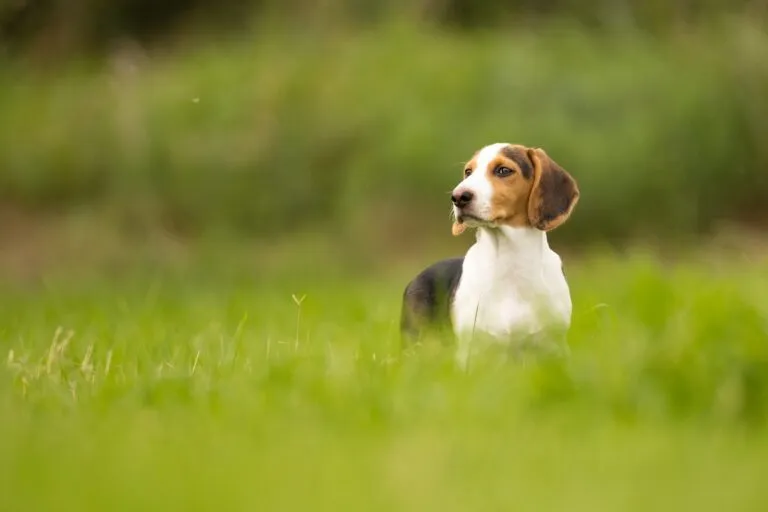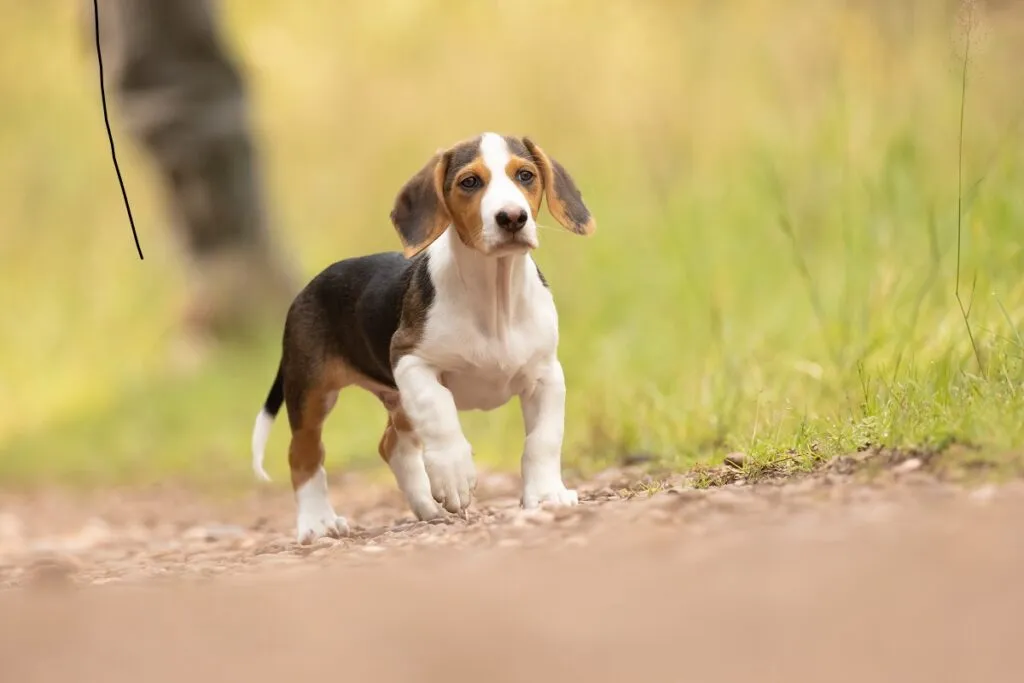Medium Size Poodle
The Westphalian Dachsbracke, also known as the Sauerland Dachsbracke, is a small, versatile hunting dog from Germany. With its friendly character, it can also be well-suited as a family dog provided that its need for exercise is satisfied and its hunting instinct is fulfilled.

© Liddy Lange / stock.adobe.com
The Westphalian Dachshund loves nothing more than being outdoors.
The Westphalian Dachsbracke is a small, low-legged hunting dog. Members of this breed reach a height at the withers of 30 to 38 centimeters. Typically, they have a strong, compact build and an elongated back. The head appears stretched out and noble.
The weight of the Westphalian Dachsbracke is around 18 to 24 kilograms. The fur is dense and short, with the hair being rather coarse.
The classic colouring is tricolour, meaning the dogs have a red to yellow base colour with a black saddle and white markings. In addition to a blaze, these animals have a white muzzle, neck ring, belly, and a light-coloured chest, tail tip, and white limbs. Two-coloured dogs, specimens with black heads, as well as the chocolate brown colour are not desired according to the breed description.
Westphalian Dachsbrackes are known as cheerful, affectionate four-legged friends. They get along splendidly with children and blend harmoniously into family life – as long as they are physically and mentally occupied.
If acclimatised to living with cats from puppyhood, the animal houseshare can function despite the hunting instinct.
As Westphalian Dachsbrackes are hunting dogs, they should be allowed to pursue their destiny. These active, energetic four-legged friends need to be challenged; otherwise, there may be issues at home.
Dogs of this breed bond closely with their humans. The adaptable feline friends want to be included in everything – and as a result, struggle with being left alone.
When training a Westphalian Dachsbracke, patience and loving consistency are required because this clever four-legged friend will readily take advantage of any weaknesses in leadership. Since these dogs are born with a tendency for frequent and loud barking, they are less suited for city or apartment living. In a rural setting, in a house with a large garden, these active animals are much better off.
Westphalian Dachsbrackes have a strong hunting drive and high need for exercise, so they need to be extensively occupied every day.
These animals enjoy long walks and are ideally suited for demanding activities such as mantrailing and tracking work due to their keen sense of smell.
And they truly thrive during playtime together. The most important thing is to keep it interesting!
The Westphalian Dachsbracke feels most at home in the forest. These compact hunting dogs are preferably used in small hunting grounds where larger dogs cannot easily navigate. Their specialties include flushing out games such as hares, rabbits, and foxes. They also perform loyal service in driven hunts for game like deer and wild boar. Blood trailing – the search for downed game – as well as finding and retrieving small game are also among their tasks.
The short coat doesn’t require much care. Regular, preferably daily brushing is sufficient to keep the fur free from dirt. Good to know: This breed doesn’t experience very pronounced shedding.
As for its diet, this four-legged friend isn’t too fussy. Like all dogs, it requires high-quality, nutrient-dense food, with portion sizes adjusted to its activity level. Whether dry or wet food ends up in the bowl, or if BARFing is considered, is up to the discretion of the owner.
This breed is considered robust and not prone to diseases. Breed-specific ailments are not known. However, their medium-length, wide floppy ears can sometimes cause problems, as they can be prone to infections.
Intense itching accompanied by frequent scratching at the head indicates painful otitis externa, which should be medically treated as quickly as possible.
Since these dogs don’t cope well with high temperatures, they shouldn’t have to exert themselves on hot days. Instead of challenging hunting outings, shorter walks in the early morning and later evening hours are recommended.
With proper care, the life expectancy of this breed is 10 to 15 years. Plenty of exercise, a healthy diet, and regular vet visits contribute to a long, happy canine life.
The Westphalian Dachsbracke is a hunting dog from the German state of North Rhine-Westphalia. The breed came about in the 1880s when hunters began crossing short-legged German Brackens with Steinbracke dogs.
However, the Steinbracke is no longer a separate breed – it has merged into the German Bracke. The goal of this breeding was to produce a sturdy, efficient low-legged dog well-suited for use in small hunting areas.
The March Revolution of 1848 brought about societal changes, including the reduction in hunting areas. The term “Dachsbracke” was first used in 1886. Since 1954, the breed has been officially recognised.
Due to a narrow breeding base, the Westphalian Dachsbracke is one of the most endangered hunting dog breeds. In Germany, on average, only about 35 puppies per year are born. To expand the gene pool and secure the survival of the breed, Drevers are occasionally crossed in. This Swedish dog breed originated from the Westphalian Dachsbracke.
 © Liddy Lange / stock.adobe.com
© Liddy Lange / stock.adobe.com
Westphalian Dachsbrackes are not very widespread and thus hard to come by. In Germany, puppies of this breed are exclusively placed through the German Bracken-Club and are typically only given to hunters. The purchasing price is usually around 1,500 Euros or more.
The purchase of a puppy is often subject to various conditions. For instance, purebred animals must usually participate in certain performance and aptitude tests, as well as bench shows.
Moreover, the dogs must be made available for at least one litter to ensure the continuation of the rare breed.
This small, compact canine is not a dog for everyone. It needs plenty of exercises, wants to use its nose, and is often sold only to active hunters. Those who are fortunate enough to be able to own a Westphalian Dachsbracke have a faithful friend for life.
| Quick Info: | Low-legged hunting dog that has evolved from the German Bracken. Particularly suitable for flushing and driven hunts, and for blood trailing. |
| Withers Height: | 30-38 cm |
| Weight: | 18-24 kg |
| Average Lifespan: | 10-15 years |
| Price: | from approx. €1,500 |
| Temperament: | cheerful, intelligent, affectionate, playful, active |
| Fur: | short and dense |
| Fur Colours: | Red or Yellow with a black saddle and white markings |
| Training Effort: | moderate |
| Grooming Effort: | moderate |
| Exercise Needs: | high |
| Demands: | high |
| Origin: | Germany |
Here are some purchase proposals curated by the zooplus editorial team
The products featured have been carefully selected by our editorial staff and are available at the zooplus online pet shop. The selection does not constitute advertising for the mentioned brands.
Fans of the Bearded Collie agree that those who aren't familiar with this dog breed simply have to get acquainted with it. And those who have experienced how a Bearded Collie bolts across meadows with its flowing fur, how it rolls around full of energy and joy and how it attentively and observantly takes into account its owners wishes become simply addicted to this original dog breed and its unique charm.
The Goldendoodle isn't a breed, but a pairing between Golden Retrievers and Medium or Standard Poodles. Marketed as a low-maintenance dog for allergy sufferers, this hybrid is enjoying increasing popularity amongst dog lovers, similar to the Labradoodle.